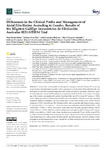Mostrar o rexistro simple do ítem
Differences in the Clinical Profile and Management of Atrial Fibrillation According to Gender. Results of the REgistro GallEgo Intercéntrico de Fibrilación Auricular (REGUEIFA) Trial
| dc.contributor.author | Durán-Bobín, Olga | |
| dc.contributor.author | Elices-Teja, Juliana | |
| dc.contributor.author | González-Melchor, Laila | |
| dc.contributor.author | Vázquez-Caamaño, María | |
| dc.contributor.author | Fernández-Obanza, Emiliano | |
| dc.contributor.author | González-Babarro, Eva | |
| dc.contributor.author | Cabanas-Grandío, Pilar | |
| dc.contributor.author | Piñeiro-Portela, Miriam | |
| dc.contributor.author | Prada-Delgado, Oscar | |
| dc.contributor.author | Gutiérrez-Feijoo, Mario | |
| dc.contributor.author | Freire, Evaristo | |
| dc.contributor.author | Díaz-Castro, Oscar | |
| dc.contributor.author | Muñiz, Javier | |
| dc.contributor.author | García-Seara, Javier | |
| dc.contributor.author | González-Juanatey, Carlos | |
| dc.date.accessioned | 2021-09-28T08:01:42Z | |
| dc.date.available | 2021-09-28T08:01:42Z | |
| dc.date.issued | 2021-08-27 | |
| dc.identifier.citation | Durán-Bobín, O.; Elices-Teja, J.; González-Melchor, L.; Vázquez-Caamaño, M.; Fernández-Obanza, E.; González-Babarro, E.; Cabanas-Grandío, P.; Piñeiro-Portela, M.; Prada-Delgado, O.; Gutiérrez-Feijoo, M.; Freire, E.; Díaz-Castro, O.; Muñiz, J.; García-Seara, J.; Gonzalez-Juanatey, C. Differences in the Clinical Profile and Management of Atrial Fibrillation According to Gender. Results of the REgistro GallEgo Intercéntrico de Fibrilación Auricular (REGUEIFA) Trial. J. Clin. Med. 2021, 10, 3846. https://doi.org/10.3390/jcm10173846 | es_ES |
| dc.identifier.issn | 2077-0383 | |
| dc.identifier.uri | http://hdl.handle.net/2183/28522 | |
| dc.description.abstract | [Abstract] To analyze the clinical profile and therapeutic strategy in atrial fibrillation (AF) according to gender in a contemporaneous patient cohort a prospective, multicenter observational study was performed on consecutive patients diagnosed with AF and assessed by cardiology units in the region of Galicia (Spain). A total of 1007 patients were included, of which 32.3% were women. The mean age of the women was significantly greater than that of the men (71.6 versus 65.7 years; p < 0.001), with a higher prevalence of hypertension (HTN) and valve disease. Women more often reported symptoms related to arrhythmia (28.2% in EHRA class I versus 36.4% in men), with a poorer level of symptoms (EHRA classes IIb and III). Thromboembolic risk was significantly higher among women (CHA2DS2-VASc 3 ± 1.3 versus 2 ± 1.5), in the same way as bleeding risk (HAS-BLED 0.83 ± 0.78 versus 0.64 ± 0.78) (p < 0.001), and women more often received anticoagulation therapy (94.1% versus 87.6%; p = 0.001). Rhythm control strategies proved significantly less frequent in women (55.8% versus 66.6%; p = 0.001), with a lesser electrical cardioversion (ECV) rate (18.4% versus 27.3%; p = 0.002). Perceived health status was poorer in women. Women were older and presented greater comorbidity than men, with a greater thromboembolic and bleeding risk. Likewise, rhythm control strategies were less frequent than in men, despite the fact that women had poorer perceived quality of life and were more symptomatic. | es_ES |
| dc.language.iso | eng | es_ES |
| dc.publisher | MDPI | es_ES |
| dc.relation.uri | https://doi.org/10.3390/jcm10173846 | es_ES |
| dc.rights | Atribución 4.0 Internacional (CC BY 4.0) | es_ES |
| dc.rights.uri | https://creativecommons.org/licenses/by/4.0/ | * |
| dc.subject | Anticoagulation | es_ES |
| dc.subject | Atrial fibrillation | es_ES |
| dc.subject | Gender | es_ES |
| dc.subject | Rhythm control | es_ES |
| dc.title | Differences in the Clinical Profile and Management of Atrial Fibrillation According to Gender. Results of the REgistro GallEgo Intercéntrico de Fibrilación Auricular (REGUEIFA) Trial | es_ES |
| dc.type | info:eu-repo/semantics/article | es_ES |
| dc.rights.access | info:eu-repo/semantics/openAccess | es_ES |
| UDC.journalTitle | Journal of Clinical Medicine | es_ES |
| UDC.volume | 10 | es_ES |
| UDC.issue | 17 | es_ES |
| UDC.startPage | 3846 | es_ES |
| dc.identifier.doi | 10.3390/jcm10173846 |






